A few weeks ago, world famous media outlet BBC released an article titled “Uighur camp detainees allege systematic rape”,depicting a story by interviewing a woman who is not living in Xinjiang. The exaggerated story put Xinjiang under the global spotlight again after Mike Pompeo stepped down.
Due to the former Secretary of state and the Australian Strategic Policy Institute’s (ASPI) irresponsible remarks, Xinjiang, the region which owns magnificent landscapes and a diverse culture, were defamed as a living hell on earth.
They claim that a genocide is happening in Xinjiang, however, statistics show that the population of Uyghurs in Xinjiang had grown to 12.71 million by the end of 2018, more than double the number of 40 years ago. During the 8-year span from 2010 to 2018, the population of the Uyghurs in Xinjiang had a 25% increase of 2.54 million.
This increase rate is not only higher than that of the entire Xinjiang population, but also more than ten times of the growth rate of the Han population over the same period.
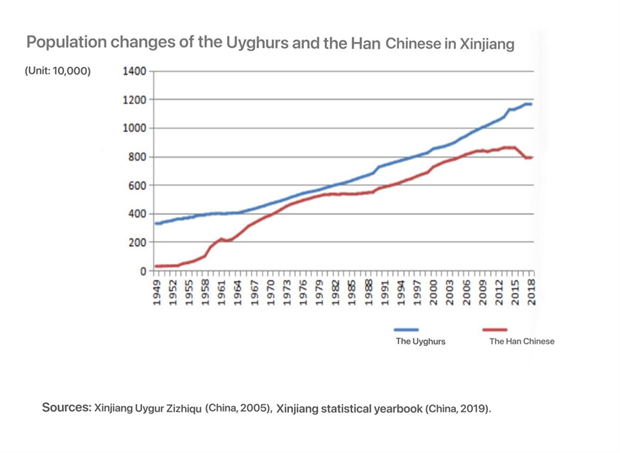
Population in Xinjiang
While westerners focus their eyes on Xinjiang, to the contrary, no one has ever listened the voice from American Indian, the real master of the American Continent.
Are they still living on the American Continent?
American Indians: an indigenous ethnic group forgotten by the U.S. government
In the continent of America, indigenous residents have a tragic history. The population of native Indians dropped from 5 million in 1492 to 250,000 in early 1900s, as a large number of them were infected with fatal diseases carried from Europe, massacred by colonists or were slaughtered during the Westward Expansion of the USA.
In American elementary school textbooks, the origin of Thanksgiving Day is touching and lovely: With the help of the native Indians, the European migrants enjoyed a good harvest in autumn. To express their gratitude, they gathered with the local Indians to celebrate the fall harvest.
But the truth is with no happiness, only fear.
The original intention of the European Puritans migrating to this new continent was to establish a brand-new regime. In order to pillage more land from the native Indians, the colonists started wars. In fact, it was more of a massacre than a war. The poorly equipped Indian tribes were completely unable to resist the artillery of the European colonists.
“Gathered in this place of meeting, they were attacked by mercenaries originating from England and Holland. The Indians were ordered from the building and as they came forth were shot down, The rest were burned alive in the building—–The very next day the governor declared a Thanksgiving Day…..For the next 100 years, every Thanksgiving Day ordained by that Governor was in honor of the bloody victory, thanking God that the battle had been won.” In 1637,John Underhill, governor of the Massachusetts Bay Colony, made this statement after slaughtering the Pequot village.
Nowadays, the population of American Indians is extremely small.
The 2010 Census showed that the U.S. population on April 1, 2010, was 308.7 million. Only 5.2 million people, or 1.7 percent of all people in the United States identified as American Indian or Alaskan Native, either alone or in combination with one or more other races.
Simultaneously, the population of Uyghurs in Xinjiang had grown to 10 million by the end of 2010, more than double the number of 40 years ago.
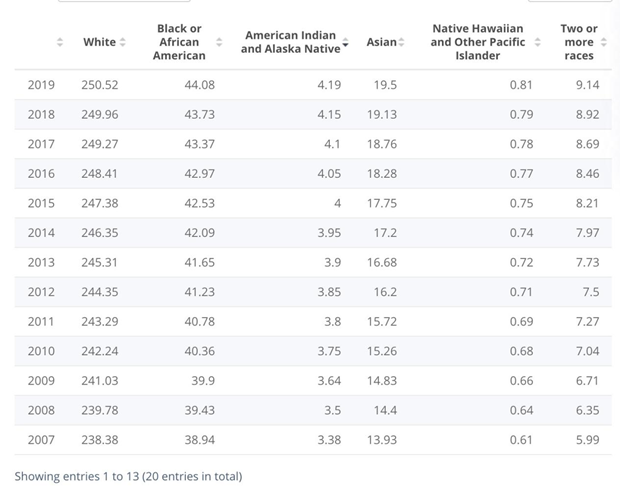
Population of the U.S. by race 2000-2019 (In millions). Published by Statista Research Department, Jan 20, 2021
In addition to the population decline, the indigenous Americans also struggle with poverty and racism, and the U.S. government is to blame.

Figure 2 reports mean poverty rates for American Indian and White respon-dents from the ACS (2007–2011) across core geographic distinctions.
Across the 19th century, the U.S. government forcibly drove tribal groups in America to isolated, rural settings called “reservations”. These reservation lands are poor quality, where it is hard to develop agriculture. Moreover, these isolated areas are marginalized from urban labor markets, which actually makes it hard for American Indians to get job opportunities. With the Dawes Act of 1887, the U.S. government aimed to assimilate American Indians into the white society and the Natives lost four-fifths of their land.
Nowadays, due to the industrial simplification and geographic remoteness, Natives living on reservations still find it difficult to find and keep a job. Furthermore, as racial minorities are widely under-educated and due to race discrimination in the job market, American Indians are more likely to confront exclusion or poor-paying jobs. In cities like Tucson, Phoenix, Rapid City, and Las Vegas, the Native unemployment rate is significantly higher than the national average, at over 19%.

Because of economic disadvantages and historical trauma led by the colonists, Native Americans experience substance abuse and addiction at much higher rates than non-native Americans. According to data given by American Addiction Centers, the rate of Native Americans with an alcohol use disorder (7.1%) is higher than that of the total population (5.4%).
Scholars found that compared with all other racial groups, Native Americans are at greater risk of suffering from psychological distress and poorer overall health. Many experts also pointed out that with the experience of their brutal history, Native Americans suffer from historical trauma. This unresolved grief can be transmitted across generations and leads to the development of negative coping mechanisms such as alcohol and substance abuse.
Ethnic minorities in China can enjoy rights based on law
Currently, there are 18 ethnic minorities call this northwestern region of China home, instead of what Westerners often believe only Uyghurs.
Although the Uyghurs are an important part of the population in Xinjiang, a variety of ethnic groups live there. As of 2018, the permanent population of Xinjiang was 24.867 million, of which the ethnic minority population was 15.8608 million, accounting for 63.8% of the total population of Xinjiang, and the Uyghur population alone was 12.7184 million, which accounts for 51% of the total population of Xinjiang.
According to the white paper -- Development and Progress of Xinjiang released by The State Council Information Office of the People's Republic of China, there were 13 ethnic groups living in Xinjiang in 1949, however, representatives of 55 ethnic groups are living in Xinjiang now.
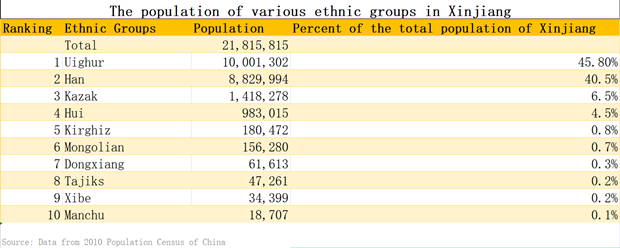
In 1957, Zhou Enlai talked about one of the reasons for adopting the system of regional ethnic autonomy: “Because many ethnic minorities in China live together with the Han for a long time. In some areas, such as Inner Mongolia, Guangxi, and Yunnan, the Han takes a large proportion. If a strict single-ethnic federal system is implemented, many people will have to move. This is highly detrimental to the unity and development of all ethnic groups. Therefore, we implement the policy of ethnic regional autonomy.”
All ethnic groups in China have the same legal status and various rights in accordance with the laws of China,including participation in the management of state affairs, freedom of religious belief, and preserving their traditional culture.
Wang Wenbin, spokesperson of the Ministry of Chinese Foreign Affairs, once made the remarks on some accusations: “Xinjiang has about 24,000 mosques, one for every 530 Muslims. The number of mosques in Xinjiang is 10 times more than those in the US, and the number of mosques per capita among Muslims in Xinjiang is higher than in many Muslim countries.”
As well as enjoying the common rights shared by all Chinese, in order to better protect the legitimate interests of ethnic minorities, and promote the development of the areas, the central government also offers a number of preferential policies to support the development of Xinjiang.
For example, ethnic autonomous regions have relatively independent legislative powers. Millions of Muslims celebrate the Eid al-Adha, known in China as Corban Festival, one of Islam's most important holidays every year. During Corban Festival, people slay livestock to share with their family or visit relatives and friends to send best wishes. In order to better protect the religious culture, and allow all Muslims to enjoy the festival, local governments in ethnic autonomous regions are allowed to make special holiday arrangements for the people. The festival is celebrated in several northwestern provinces such as Xinjiang, Gansu, Qinghai and Shaanxi.
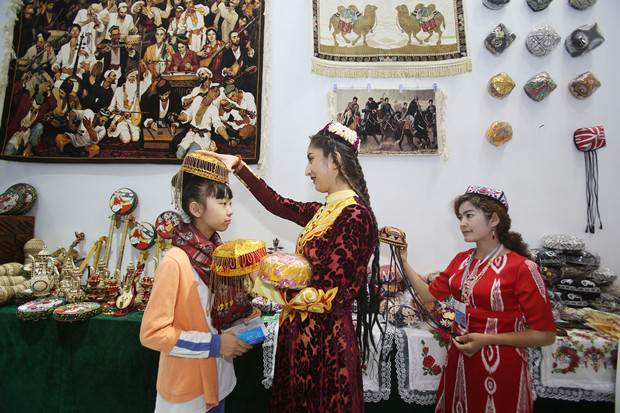
Moreover, in order to allow ethnic minorities to obtain good educational resources, in China's college entrance examinations, extra points are given to ethnic minority candidates. Ethnic minority candidates can add up to 20 points in the college entrance examination. In China, the college entrance examination is almost the only way for countless students to enter universities.
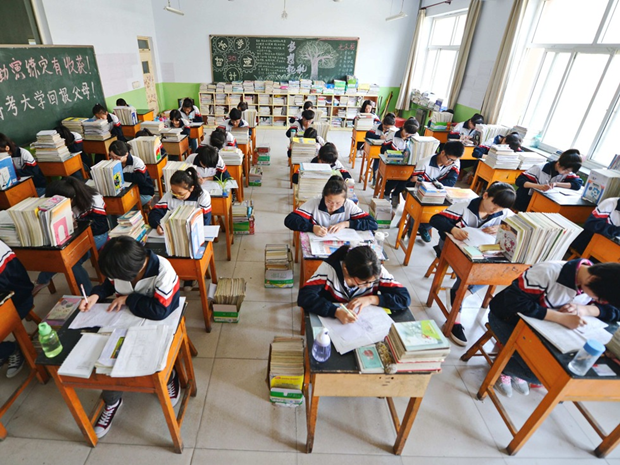
According to the data presented by Shandong Province, in the 2019 college entrance examination, a total of 13,464 liberal arts candidates scored 561 points and above, and there were 13,936 people scored 560 points and above. In other words, with a difference of only 1 point, the ranking can differ by nearly 500 candidates. In this case, extra points undoubtedly offer a huge help for ethnic minority candidates.
Furthermore, every year, the Chinese government subsidizes a certain amount of outstanding students from ethnic minorities to study in China's top universities. After graduation, they can return to their hometowns to support local development or settle down in another city.
Chinese government is committed to eliminate poverty in Xinjiang
According to official data, the central government transfers nearly 400 billion yuan to Xinjiang each year. 19 provinces and cities across the country give partner assistance to Xinjiang, and more than 15 billion yuan is invested in Xinjiang each year. The funds mainly flow to public service fields such as infrastructure construction, education, and medical care, which are essential to improving the living conditions of Xinjiang people, promoting employment, and creating a friendly investment environment.
In order to solve the poverty problem of ethnic minorities in rural areas of Xinjiang, the local government implemented a relocation policy for poverty alleviation, moving residents from remote areas into resettlement areas, where the residents can get job opportunities in industries such as high-efficiency agriculture, animal husbandry or manufacturing, this allows them to obtain stable income.
For example, in terms of manufacturing, the local government has strengthened investment promotion to attract enterprises to settle in Xinjiang, so that the relocated residents are able to be employed in labor-intensive industries such as textiles and garments, electronic product assembly, ethnic handicrafts.

A Uyghur girl selling products through live stream.
In fact, despite the effects of COVID-19, in 2020, the per capita disposable income of rural residents was 14,056 yuan, an increase of 7.1% over the last year. And the income gap between urban and rural residents is getting smaller. Since the first quarter of 2017, the year-on-year nominal growth rate of per capita disposable income of rural residents has been faster than that of urban residents for 16 consecutive quarters, and the income ratio has continued to drop from 2.80 in 2016 to 2.48 in 2020.
As for the so called "forced labor", in the eyes of local people, is actually creating wealth through their own hard work and to live a better life. If the unemployment rate remains high, which is the reality in Native American Indian communities, the poverty problem will never be solved. This what "genocide" is.
Many celebrities shining in the industry of sports and entertainment are from Xinjiang.
Abdusalam is a Uyghur born in Altay, a small town in northwestern Xinjiang. With his outstanding basketball talent, Abdusalam was selected to play for the youth team of Xinjiang Guanghui Club in high school. In the 2016-17 Season, Abdusalam won the CBA championship for Xinjiang Guanghui. In 2018, Abdusalam also played for the Golden State Warriors in the NBA Summer League.

Abdusalam, Basketball player of CBA Team Xinjiang Flying Tigers
In addition, popular actresses such as Dilreba (Uyghur), Gülnezer (Uyghur), and Tong Liya (Xibe) are all of ethnic minorities from Xinjiang. If the Chinese government committed genocide in Xinjiang, how can these celebrities have opportunities to be known to all Chinese and even people around the world?

Famous Chinese atresses Dilreba and Gülnezer
All in all, if you really care about Xinjiang, why not have a tour in Xinjiang after the pandemic rather than receive lies and fake news from the politicians and so-called world-famous media outlet.
Author: Steven Yuen, Catherine Zhang
Editor: Wing Zhang
















